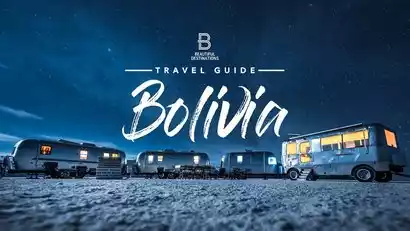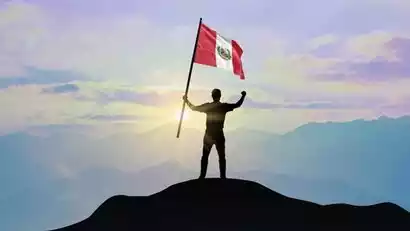Day 1 Beijing → Paris → Lima (Peru)
All day
Tourists are requested to gather at Beijing Capital International Airport 3 hours before your flight departure time and take a connecting flight to Lima, the capital of Peru.


Day 2 Paris → Lima
All day
Transfer in Paris to Lima, the capital of Peru.
Note* Transit visa is not required for transit in Paris.
After arriving in Lima, check in to the hotel to rest and relieve the fatigue caused by the flight.


Day 3 Lima Day Trip
·morning
After breakfast, we will start our day trip to the city. Lima is divided into two parts: the old city and the new city.
First, explore Lima's Old Town, a World Heritage Site. Its streets stretch from northwest to southeast, parallel to the Rimac River. The Plaza de Armas, the city's center, is renowned. From this square, streets radiate outward, reaching every corner of the city. Paved with large stone slabs, the streets exude an antique charm. In the center of the square stands a fountain, its splashing water and misty mist shimmering in the sunlight, adding a vibrant touch to the city.
Next, we'll head to Plaza San Martín. In the 16th and 17th centuries, the square was surrounded by numerous small shops and vendors. It was once used as a bullfighting ring and the site of executions during the Inquisition. The central square was the site of important celebrations, including General San Martín's declaration of Peru's independence.
Afterwards, we'll visit the Monastery of San Francisco, renowned for its catacombs, which contain over 70,000 burials, and its library, which houses countless ancient scriptures. The church itself is one of Lima's best-preserved colonial churches, influenced by the Moorish Baroque style.
·afternoon
Afterwards, we will drive to the new city of Lima, visit the wealthy area of Miraflores, Love Park, and Changhai Entertainment Center, and experience the most beautiful seaside scenery of Lima.
Visit the local Inca Market: a bustling open-air market selling souvenirs, antiques and local handicrafts.
·night
After dinner, check in to the hotel and rest.


Day 4 Lima → Iquitos → Amazon Rainforest
·morning
Reference flight: LA2019 Lima-Iquitos 11:40-13:30
In the morning, take a flight to Iquitos, then drive (about 40 minutes) to Explorama Pier to start your journey into the Amazon rainforest!
Upon arrival, check in to the Rainforest Hotel.
·afternoon
After lunch, you'll embark on a jungle hike: Follow your guide into the pristine rainforest, where he'll introduce you to local plants, fruits, and insects. The plants you encounter are new to you, and you'll be delighted to sample exotic fruits under your guide's guidance.
In the evening, if the weather is good, tourists will have the opportunity to enjoy the beautiful sunset over the Amazon River.
·night
After dinner, if time permits, you can follow the guide for a night visit to the rainforest to look for various creatures in the rainforest.


Day 5 Amazon Rainforest → Iquitos → Lima
·morning
Today is the second day of our exciting Amazon rainforest trip!
In the morning, we took a boat and encountered pink pufferfish. There are pufferfish in the Amazon River. Their mouths are long and pointed, which is a little different from what tourists have seen before.
Note: Since pink dolphins do not appear every day, there is no guarantee that you will be able to see them. Please understand!
We then visited the Native American Village. Here, we saw local handicrafts being made and saw the elders using unique hunting tools. We also had the opportunity to get up close and personal with sloths, which are adorable and slow-moving. Many tourists have probably seen the Disney animated film "Zootopia," where the animal star, Lightning, is a sloth.
Afterwards, the tourists will go piranha fishing. Amazon piranhas are quite famous, but their teeth are very sharp, making them difficult to catch. They can eat the bait without swallowing the hook, which requires a lot of skill and patience.
·afternoon
In the afternoon, proceed to the airport in time to catch your flight back to Lima.
Reference flight: Iquitos-Lima LA2235 16:10-17:55
·night
Upon arrival in Lima, check in to the hotel and rest.


Day 6 Lima → Cusco → Urubamba
·morning
Reference flight: Lima-Cusco LA2007 09:20-10:45
After breakfast, we will transfer to the airport and fly to Cusco, the ancient capital of the Inca Empire. Upon arrival, we will enjoy a special alpaca lunch.
Many people come to Cusco for Machu Picchu, one of the Seven Wonders of the World. This ancient city, nestled deep in the Andes, was once the capital of the Inca Empire and the center of politics, culture, and religion. During the Spanish invasion of the 16th century, most of the Inca-era architecture was destroyed, and the colonists rebuilt the colonial-style Cusco on top of the original foundations. Despite this, monuments like the Temple of the Sun and Sacsayhuamán have survived. The city itself is a living historical museum, reflecting the rise and fall of civilization.
·afternoon
In the afternoon, we will enjoy a sightseeing tour of Cusco: the Temple of the Holy Water, Sassahuaman, an important military fortress during the Inca Empire, the giant stone fortress that employed 30,000 people a day and took 80 years to build, and the Plaza de Armas that carries endless history.
·night
Afterwards, we will take a bus to Urubamba in due time and check into the hotel to rest after dinner.


Day 7 Urubamba → Machu Picchu → Urubamba → Cusco
·morning
After breakfast, board the Inca Trail Panoramic Train. With breathtaking 180-degree views of cliffs, rapids, and breathtaking scenery, this train experience rivals even airline-grade service and promises to be a memorable one for tourists! The train journey continues to the foot of Machu Picchu (approximately 1.5 hours), where you'll arrive at the "Lost Inca City" of Machu Picchu.
The entire Machu Picchu site, perched atop a ridge approximately 2,350 meters above sea level, overlooks the Urubamba River Valley and is surrounded by tropical jungle. It is considered one of the New Seven Wonders of the World. The renowned Chilean poet Pablo Neruda wrote in his poem "From the Summit of Machu Picchu": "I saw ancient stone buildings nestled among the verdant Andean peaks, and torrents cascading down from a citadel eroded by centuries of wind and rain..."
Upon arrival, admire the Sun City Temple, ancient canals, ancient terraced fields, and the Three Window Hall from afar. See how ancient people transformed huge stones into smaller pieces for building houses. It's said that the 3-meter-tall and 6-meter-wide stone in the site can replenish people's energy. Tourists can also get up close and personal with the local mythical alpacas, whose gentle demeanor makes them a great place to pose for photos and interact with them.
·afternoon
Enjoy a local speciality meal for lunch. At around 4:00 PM, take a train (1.5 hours) and then a car (1.5 hours) back to Cusco.
Special note* The travel time on this day needs to be reconfirmed based on the train ticket purchased.
·night
Upon arrival in Cusco, enjoy dinner and then check into the hotel to rest.


Day 8 Cusco (Peru) → La Paz (Bolivia)
·morning
Reference flight: Cusco-La Paz AV105 12:30-14:45
Enjoy breakfast at the hotel and sleep in naturally today. Then head to the airport to fly to La Paz, Bolivia.
·afternoon
Upon arrival, the tour guide will pick you up at the airport and after checking into the hotel, tourists can move freely.
Warm reminder: You will take an early flight to a high-altitude area tomorrow. It is recommended to ensure adequate rest and adjust your physical condition.
·night
After dinner, the team checked into the hotel to rest.
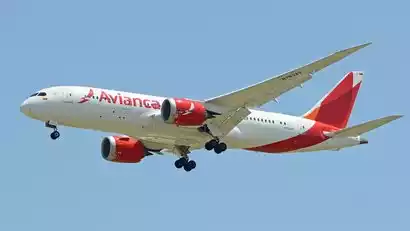
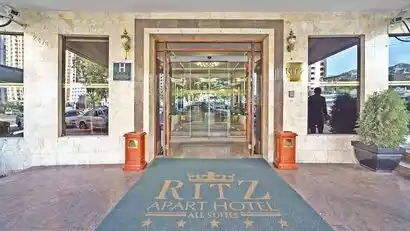
Day 9 La Paz → Uyuni
·morning
Reference flight: La Paz-Uyuni OB304 07:40-08:40
Take a small inland plane to Uyuni.
Afterwards, we'll drive to the salt flats, visiting a train graveyard along the way. The town of Uyuni was once a major trading hub in western Bolivia. With changes in transportation, abandoned steam trains are now piled high in the desert, creating a unique landscape. We'll then drive to the village of Quercaní, where we'll visit a local salt factory and handicraft market. We'll then take a 4WD into the salt flats to explore the magnificent Sky Mirror.
Lunch will be enjoyed in the middle of the salt lake, in the white world.
·afternoon
After dinner, we will take a short break at the hotel before continuing to indulge in the incredible charm of the Uyuni Salt Flats.
·night
In the evening, we sat on the edge of the salt lake, waiting for the sunset and taking photos of the gorgeous changes in light and shadow. After watching the sunset, we returned to the famous hotel on the salt lake. All the furniture was made of salt, and even the ground was covered with fine salt sand.
After dinner, go to bed early and prepare for the Uyuni photography feast (starry sky + sunrise) at dawn tomorrow.
Tip: Uyuni is located at an altitude of approximately 3,600 meters. Please consider whether to bring any medication for altitude sickness based on your health. Uyuni's famous salt lakes are a must-see. For stunning photos, bring rain boots and explore the lake.
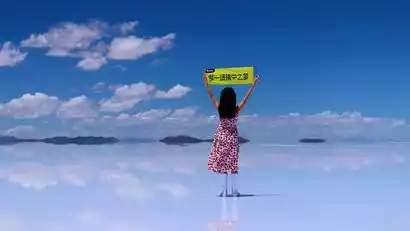
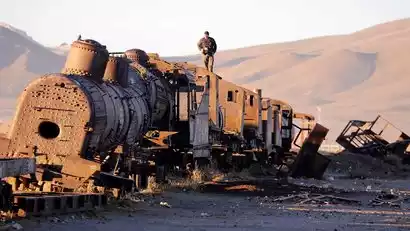
Day 10: Day trip around Uyuni
·morning
If the weather is clear, wake up at 3:30 AM and start your Uyuni Sky Mirror - Starry Sky + Sunrise photography. As the moon sets, the vast Milky Way fills the sky with stars, creating a perfect opportunity for astrophotography. Seize every moment of this moment, as you'll never have another chance to surpass it. As time passes, let's quietly admire the moving Sky Mirror sunrise before returning to the hotel for breakfast.
Note: This activity is subject to weather conditions. If the weather is bad, the activity will be cancelled. Thank you for your understanding.
After breakfast, we will drive to San Cristóbal, passing through the Valley of Strange Stones. Due to the unique desert climate and environment, the rocks have weathered into various strange shapes, making it Bolivia's version of Arches National Park in the United States.
·afternoon
We will then proceed to Turquiri Lake (Black Lake), known as red amber due to the growth of microorganisms. After lunch, we will continue to Hedionda Lake (Blue Lake), a place frequented by beautiful flamingos. Tourists can capture the graceful movements of these fiery red elves with their cameras.
·night
Then we return and stay at the Salt Brick Hotel near Uyuni to rest.
Friendly reminder: Uyuni is located at an altitude of approximately 3,600 meters. Please consider whether to bring any medication for altitude sickness based on your health. Participation in the Uyuni starry sky and sunrise viewing is voluntary; if you feel unwell, you can rest at the hotel.
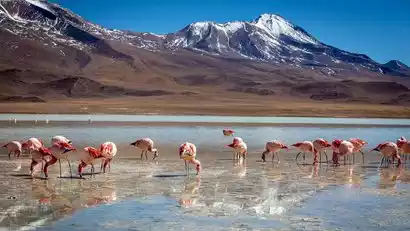
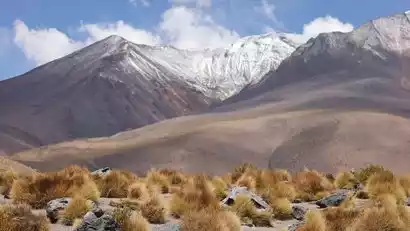
Day 11 Uyuni → La Paz
·morning
Reference flight: Uyuni-La Paz OB305 09:15-10:15
After breakfast, transfer to the airport for your flight to La Paz.
After your guide picks you up at the airport, we'll head to the Moon Valley for a tour: If you can't visit the moon, then why not visit Bolivia's Moon Valley? Located 10 kilometers outside of La Paz, Bolivia's capital, the Moon Valley is a renowned tourist attraction. Its glacial, sandy terrain creates a bizarre and treacherous landscape, evoking the illusion of being on the lunar surface. In 1969, astronaut Neil Armstrong, the first man to walk on the moon, visited the "Valley of the Moon" and remarked on its resemblance to the lunar surface, earning it the nickname "Moon Valley."
·afternoon
Enjoy a bird's-eye view of the city by cable car, explore the Plaza de San Francisco, and then visit the Inca Witch Market, the last remaining site of the dying Inca culture. Here, you'll find a wide variety of witchcraft paraphernalia, runic wood sculptures, aborted and stillborn alpacas, and peculiarly shaped dolls and figurines—a truly enchanting sight. Besides selling props, this place also serves as a place to educate those who believe in witchcraft. If a witch is in a good mood, she might offer a wealth of information.
·night
After dinner, check in to the hotel and rest.
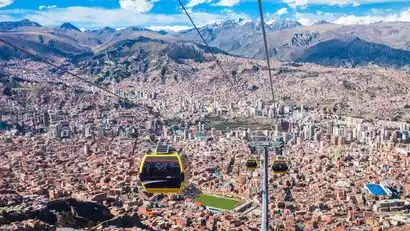
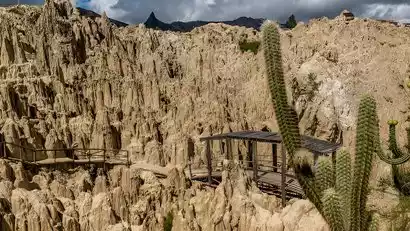
Day 12 La Paz → Tiwanaka (Bolivia) → Land Customs → Puno (Peru)
·morning
After breakfast, we will drive to Tiwanaku, a city considered the forerunner of the Inca civilization. For thousands of years, Tiwanaku was the largest and most important indigenous city in the Andes.
Tiwanaku was the capital of the ancient Latin American Indian kingdom, a powerful empire that ruled a vast area south of the Andes and beyond. Tiwanaku reached its peak between 500 and 900 AD. The civilization in this region was distinct from the ancient Latin American empires elsewhere in the Americas, and its historical remains bear witness to its cultural and political importance.
The ruins of this ancient city are located approximately 72 kilometers west of La Paz. They consist of four main parts: the Akapana Pyramid, the longest structure in the site; the Great Kalasasaya Temple, a site for Tiwanaku rituals; and the Sun Gate, a notable monument within the site, considered one of the world's greatest archaeological discoveries.
·afternoon
After lunch, we will drive to the land customs to cross the border into Peru and continue to Puno (approximately 4 hours).
Upon arrival, explore Puno city: visit the famous Plaza de Armas and the Puno Cathedral (exterior view) adjacent to the plaza. This cathedral is a classic Spanish-style building. If you're lucky, you might catch a church service and watch devout Peruvians worship. The cathedral is also bustling at night, with locals gathering to fully experience the warmth and romance of the descendants of the Incas.
Tip: If the immigration process takes a long time on the day and you arrive in Puno late, the city tour will be changed to the 13th day.
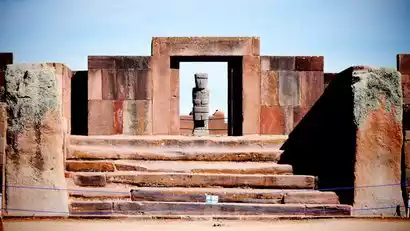
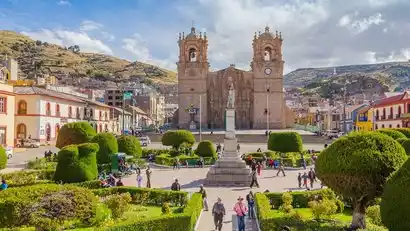
Day 13 Puno → Lake Titicaca → Juliaca → Lima
All day
After breakfast, we'll depart for Lake Titicaca and embark on the Uros, a floating island world known as the "Floating Lawn," to experience the unique lifestyle of the local Uros people. These primitive people still live the same way they did six hundred years ago.
Men go out to sea to fish, while women and children remain on the islands, living a self-sufficient life. Floating islands are made of unique reeds grown on Lake Titicaca, where entire families live a primitive life. Tourists can experience a welcoming ceremony with singing and dancing, learn about their lives with a guide, and ride on a unique reed-woven floating "Mercedes-Benz." This is also a must-see for humanistic photography.
Afterwards, we will go to Juliaca and take a flight to Lima. Upon arrival, we will have dinner and check into the hotel to rest.
Reference flight: Juliaca-Lima LA2212 17:55-19:35
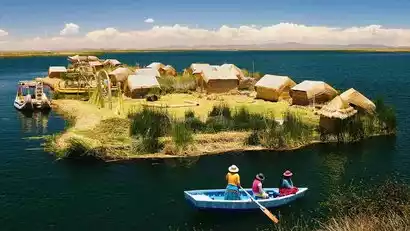
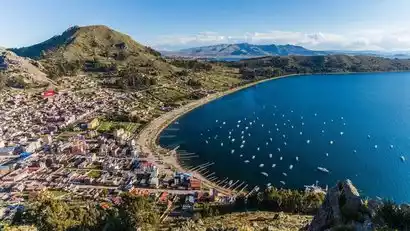
Day 14 Lima (Peru) → Amsterdam
All day
After breakfast, we will go to Callao Port and start our 4-hour boat tour.
San Lorenzo Island, Peru's largest island, is home to a large pre-Inca cemetery where tourists can admire the remains of the prison of the same name and hear its countless stories and anecdotes.
The Cavinzas Islands, with their natural rocky islets and caves, are a haven for seabirds, including pelicans, boobies, guanai, chuitas, gulls, and many other species. The ISLAS PALOMINO will allow you to admire the Guanera Islands, a complete ecosystem with a population of between 7,000 and 8,000 birds and sea lions.
Note: The specific cruise time is subject to the booked ticket time.
Afterwards, you will be free at your own leisure and then proceed to the airport in due time to start your return journey tonight.
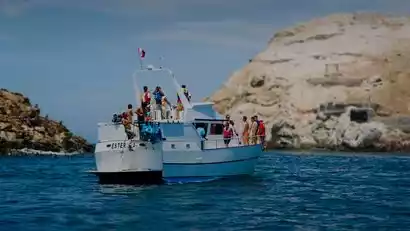
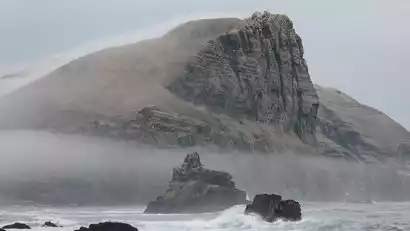
Day 15 Lima → Amsterdam → Beijing
All day
Return to Beijing via Amsterdam.
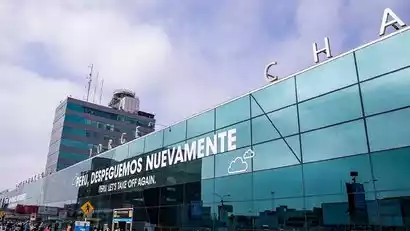
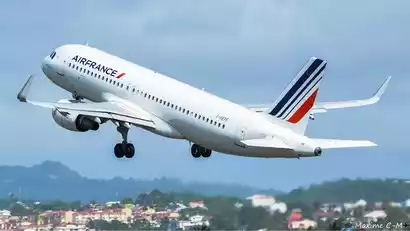
Day 16 Beijing
All day
Arriving in Beijing, the trip ends.
